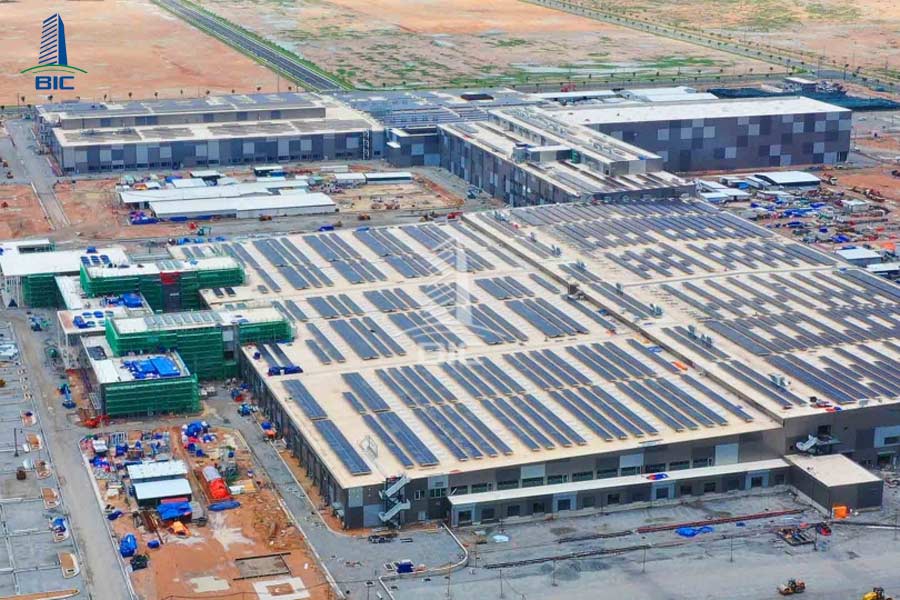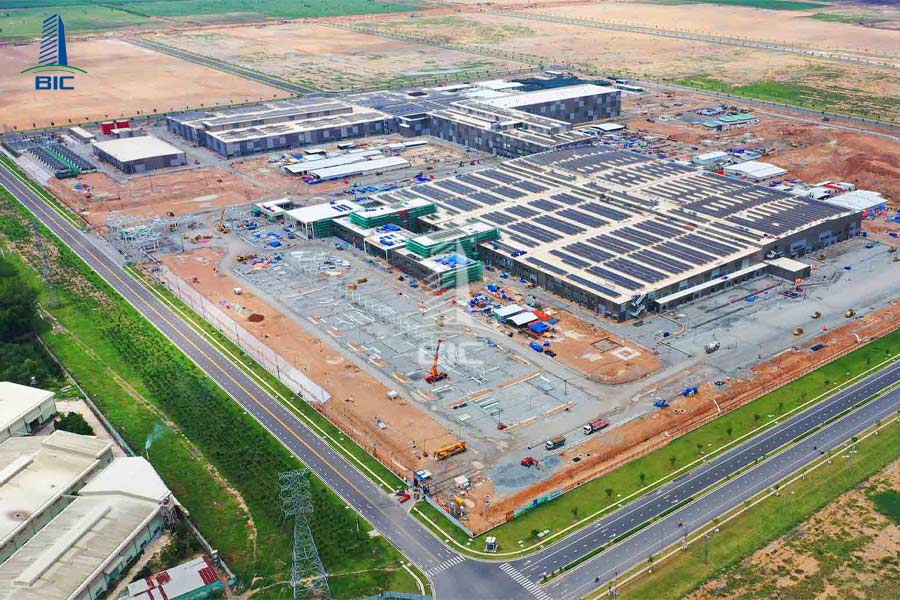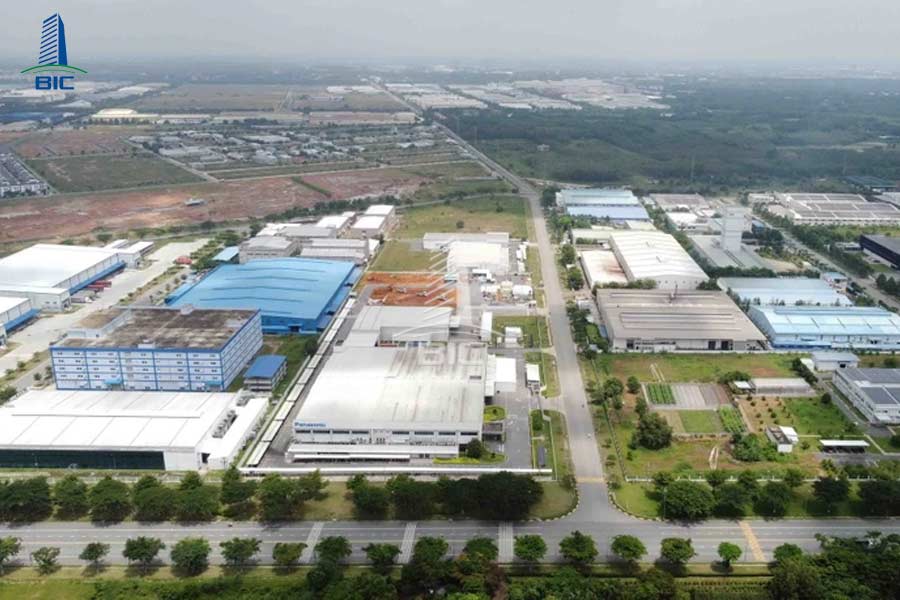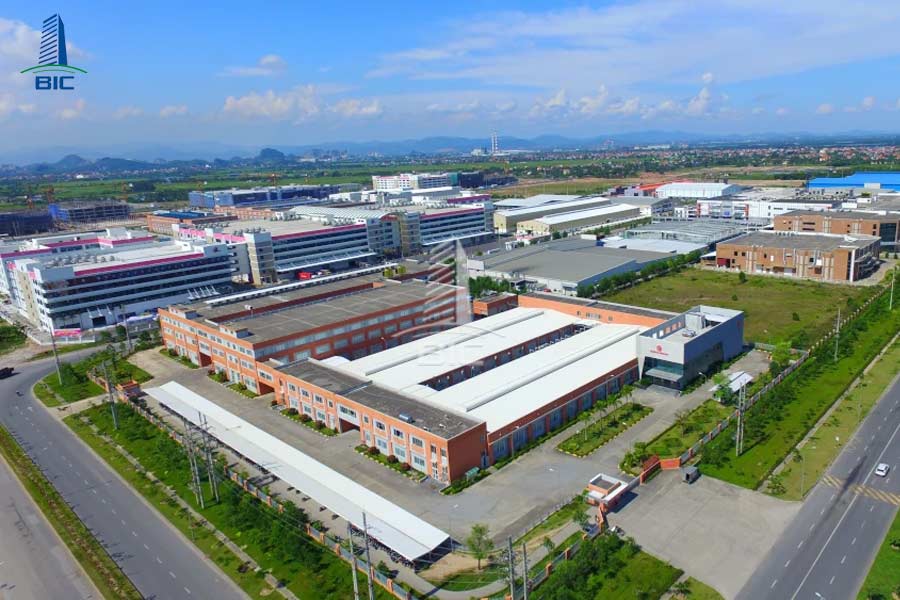
FDI (Foreign Direct Investment) capital not only serves as a key driver of economic growth but also reflects international investors' confidence in Vietnam’s business environment. In the process of establishing manufacturing operations, FDI enterprises are increasingly gravitating toward large industrial parks rather than scattered plots or areas lacking infrastructure. This preference stems not only from the need for manufacturing space but also from strategic factors such as synchronized infrastructure, transparent legal frameworks, and the ability to connect with global supply chains.
Choosing large industrial parks has become an optimal investment strategy that helps foreign enterprises shorten project implementation time, reduce risks, and improve long-term operational efficiency. In this article, BIC will analyze the core factors that make large industrial parks the top choice for foreign investors setting up factories in Vietnam.
Recent years have witnessed a notable shift in FDI flows toward Southeast Asia, with Vietnam emerging as a prominent destination. Political stability, economic growth potential, and increasingly transparent investment policies have helped Vietnam secure a significant position on the foreign investment map of the Asia-Pacific region.
FDI enterprises are no longer focusing solely on traditional high-cost markets. Instead, they are turning to countries with developed industrial infrastructure, ready-to-use land, and reformed legal procedures. In Vietnam, regions such as Binh Duong, Long An, Dong Nai, Bac Ninh, and Hai Phong are leading the trend due to advantages in transportation connectivity, abundant labor, and business-friendly local policies.
Building a manufacturing facility is not merely a step in launching business operations it plays a strategic role in expanding global supply capacity. International corporations are increasingly investing in satellite production systems in emerging economies to mitigate supply chain risks and enhance adaptability to market fluctuations. Thus, modern FDI strategies are no longer just about finding a production site, but also emphasize long-term sustainability and efficient operations.

Selecting a location for factory design construction is a strategic decision for FDI enterprises. Large industrial parks are increasingly favored due to their comprehensive infrastructure, strategic location, and support ecosystems for factory design, construction, and operation. The following are key reasons why large-scale industrial parks are the top choice for foreign investors:
Large industrial parks are usually well-developed with essential infrastructure such as internal roads, medium-voltage electricity, water supply and drainage, telecommunications, wastewater treatment, and fire protection systems. This solid foundation allows companies to significantly reduce implementation time and construction costs.
With such infrastructure, factory design consultants can efficiently allocate space, plan functional areas, organize internal traffic, and optimize technical systems, enhancing long-term operational efficiency.
Modern industrial parks are often located in strategic areas with direct access to seaports, airports, and major urban centers. These prime locations help FDI enterprises minimize logistics costs and facilitate the transportation of equipment and materials for factory construction.
Such connectivity also allows factory design teams to align production scale with global supply chains from sourcing raw materials to exporting finished products.
Labor is a critical factor in both the construction and operation of a factory. Large industrial parks benefit from proximity to densely populated areas, vocational schools, and technical universities facilitating the recruitment of skilled workers.
This is particularly helpful during construction, when a large number of workers, engineers, and site supervisors are needed. Early access to the workforce also ensures smooth operations once the plant is operational.

Current industrial park policies are designed to maximize support for FDI enterprises, including tax incentives, legal assistance, and simplified investment procedures.
In the factory design phase, large industrial park developers often work closely with investors to provide consultations on regulations and technical standards, expediting construction permits and reducing costs and legal risks.
Investing in an industrial park helps enterprises avoid many legal complications such as land disputes, suspended planning, or construction permit issues. Industrial park legal frameworks are standardized, ensuring long-term stability throughout the project lifecycle.
For large-scale projects, factory design requires tight coordination between investors, design firms, and regulatory agencies. Clearly zoned industrial parks with logical land-use plans help shorten the documentation process and ensure projects progress on schedule.
The choice of location for factory design and construction not only affects upfront investment costs but also has a lasting impact on expansion potential, operations, and legal security. Below are key differences between large industrial parks and alternatives like small parks or independent land plots:
One of the main advantages of large industrial parks is their well-planned master layout with flexible land reserves and infrastructure ready to support future expansion. This is crucial for enterprises needing to scale production or adjust technology in response to market demands.
In contrast, using independent land or smaller parks often limits expansion due to zoning constraints, lack of adjacent land, or legal hurdles making supplementary factory design and construction more complex and expensive.
During the factory design phase, enterprises must handle various procedures related to land use, construction permits, fire protection, and environmental impact assessments. Large industrial parks often provide dedicated teams to offer end-to-end legal support, technical consulting, and assistance from surveying to construction.
With independent land or smaller parks, enterprises typically handle legal procedures themselves, which can prolong preparation time, increase risks, and potentially delay project completion a clear disadvantage compared to the full-service model of modern industrial parks.

Once the factory is built, safety and long-term sustainability become top priorities. Large industrial parks are equipped with standard-compliant fire protection systems, 24/7 security, and proper drainage and waste treatment systems—ensuring stable operations and regulatory compliance.
Conversely, self-developed land or small parks often lack comprehensive technical infrastructure, making factories vulnerable to power outages, flooding, fires, or environmental conflicts with nearby communities. This not only affects production but also creates potential legal liabilities and reputational damage.
Vietnam is currently a leading destination for FDI, particularly in manufacturing and industry. Several large industrial parks have emerged as top choices thanks to thoughtful planning, strategic locations, and comprehensive support ecosystems.
The Vietnam–Singapore Industrial Park (VSIP) system started in Binh Duong and has since expanded nationwide, with over $18 billion in total investment, 900+ projects, and over 300,000 jobs created.
In Binh Duong, VSIP I and II are nearly fully occupied due to their proximity to Ho Chi Minh City, Cat Lai Port, and Tan Son Nhat Airport ideal for FDI enterprises looking to build factories near major industrial centers.
VSIP 3, covering around 1,000 hectares and focusing on high-tech, manufacturing, and food industries, has attracted over 30 international companies with total expected investment of $1.8 billion.
Amata Bien Hoa is one of Dong Nai’s earliest industrial parks, with nearly 99% occupancy and over 170 active enterprises.
Amata was selected by the Ministry of Planning and Investment and UNIDO as a pilot green eco-industrial zone with advanced wastewater treatment, energy-efficient systems, and modern environmental management.
Located at the northern seaport gateway, DEEP C covers over 3,400 hectares across Hai Phong and Quang Ninh, with more than 600 hectares of available land currently being expanded.
DEEP C offers corporate income tax exemptions, partnerships for ready-built factories, and infrastructure meeting international standards.
Long Hau is a strategic industrial park near Ho Chi Minh City. Though not part of large groups like VSIP or Amata, it remains attractive to FDI due to its convenient location and stable infrastructure ideal for medium and small factory projects.
Phuoc Dong is one of the few well-planned industrial zones in Tay Ninh to attract FDI in recent years. Though smaller in scale compared to southeastern parks, Phuoc Dong is seen as a promising location due to its clean land reserves, supportive policies, and expansion capabilities.
Each of these industrial parks offers distinct strengths—from strategic location and complete infrastructure to custom support for factory design and construction.

Choosing a large industrial park to build a factory provides many advantages but also requires FDI enterprises to prepare thoroughly from the outset. To ensure investment efficiency and minimize risks, here are essential points for foreign investors during the factory design and construction process in Vietnam:
Not every large industrial park fits all types of manufacturing. Enterprises should carefully assess factors such as the park’s industry orientation, environmental regulations, fire safety requirements, labor supply, and potential for future expansion.
The right choice ensures favorable operating conditions and directly influences factory design from functional layout and production lines to scalability and adaptability.
Large industrial parks often offer bundled services including utilities, waste treatment, security, road maintenance, and legal support. FDI enterprises should clarify lease agreements regarding usable land area, lease duration, annual fees, site handover commitments, and infrastructure timelines.
Transparent negotiations help ensure smooth implementation and serve as a foundation for timely and accurate factory design and construction.
From the pre-feasibility stage, enterprises should work with experienced factory design consultants to develop a master plan aligned with production goals and industry specifics. Efficient space planning, internal traffic design, and calculations for utilities (electricity, water, emissions treatment) will enhance operational efficiency and flexibility.
Moreover, industrial park construction is subject to zoning regulations, land-use ratios, and setback lines. A solid upfront design prevents errors or costly revisions later.
Practical experience within industrial parks is a crucial factor when selecting a design firm. A team familiar with local regulations, drawing approval procedures, and coordination with infrastructure investors can expedite documentation and construction permits.
Additionally, experienced firms can help choose suitable materials, optimize structural solutions, accurately forecast costs, and ensure the design meets all safety, technical, and environmental standards key to the success of the entire investment project.
Choosing a large industrial park for factory design and construction offers immediate benefits in infrastructure and legal readiness, but also represents a strategic move for sustainable development of FDI enterprises in Vietnam.
With synchronized infrastructure, clear planning, and professional support services, investors save time, reduce unexpected costs, and accelerate factory operations. More importantly, the modern industrial park model provides ideal conditions for scaling up, upgrading production lines, and flexibly responding to global market fluctuations.
If you're seeking an experienced partner who understands the nuances of industrial park-based factory design and offers comprehensive support from design to construction, BIC is ready to assist. Contact us to build a strong production foundation from the very first step.